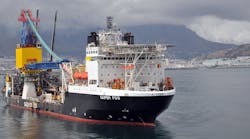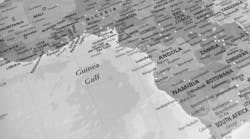Southeast Europe is the dream destination for Caspian gas exporters. But the Balkan nations crave a degree of independence. As a result, two countries are activating dormant discoveries on their own doorsteps in the western Black Sea, under the stewardship of foreign oil companies.
One development project in the Bulgarian sector could be underway next month. Another, relating to a larger field off Romania, could move ahead following appraisal drilling in 2001.
Bulgaria has no offshore production, aside from the land-based Tulenovo oilfield which extends a little ways into the sea. However, the country's offshore prospectivity was established in 1996, when a group comprising Texaco, Enterprise, OMV, and Bulgargas discovered the Galata gasfield in Block III. An appraisal well also tested gas, but two further wells on other prospects were dry.
Galata lies 16 miles offshore Varna in 35 meters of water. Measured depths of the productive wells were 900-1,200 meters. Texaco had been targeting a Mesozoic oil play, and gas - in the quantities found - was not the desired outcome. It therefore ceded control of the block to Enterprise which was also exploring neighboring Block II.
Subsequent seismic interpretation studies identified several more leads on these blocks with a cumulative potential of 400 bcf. But again, this was beneath Enterprise and Texaco's commercial threshold. Their interests in Block III, plus those of partner OMV, were sold to a new Luxembourg-registered company called Petreco in 1998. Petreco then acquired a further 15% stake in the block from the Bulgarian Ministry, bringing its total interest to 65%.
Concurrently, Petreco itself was being acquired by Melrose Resources. The Edinburgh, UK-based independent started life as a series of tax-efficient drilling partnerships, including one with Pentex. However, US tax changes in November 1996 ended the arrangement. Instead, owner Robert Adair decided to re-mold Melrose as an oil company, focusing on operations in the US and eastern Mediterranean region.
Petreco's five-man team, based in Sofia, is driving toward the development of Galata, a project headed by ex-Texaco Area Manager David Archer. The company also has opened an operations office in Varna. Go-ahead for the project in 1998 was contingent on the Block III license expiry date being extended for two years to this October.
Under the extension terms, Petreco agreed to drill at least one exploration well, once development got underway. The Bulgarian Ministry, which retains a 35% carried interest, is not liable for exploration costs, but may elect to pay its full share of the development.
Industrial power base
Currently, Bulgaria relies on Russian gas feeding through the Trans-Balkan pipeline via Ukraine and Romania. Bulgargas owns and operates the long-distance branches through Bulgaria. In recent winters, there have been supply shortages. These, allied with growing demand from new customers across Bulgaria, are spurring development of Galata.
Initially, the main buyer of Galata's gas will likely be an industrial and chemical complex at Devnija, a town inland from Varna. There is also a nearby soda ash plant that relies currently on hot water generated by a coal-fired power station. The latter is expected to convert to gas. Other potential industrial users include a power station serving a Lukoil-owned refinery in Burgas, which requires daily throughput of 35 MMcf.
Throughout Bulgaria, 15 towns are converting to gas-fired power with a further 20 also shaping up. The national distribution system also delivers 600 MMcf/d to Turkey, plus smaller quantities to Greece.
The development plan for Galata involves installation of a single production platform and a pipeline running 20 km subsea to a landfall near Varna, then veering 30 km overland to Devnija. Two production wells will be drilled to secure the plateau production rate of 45 MMcf/d, equivalent to 12% of Bulgargas' daily needs.
Once gas sales have been concluded, Petreco intends to ship across a redundant platform from Mobil's Camelot Field in the southern North Sea. The overall price for this exercise is estimated at around $30 million - a new platform built locally would have cost no more, but would have retarded the schedule.
According to Melrose's Chief Executive David Melrose, the steelwork of the Camelot platform is in good condition, and all processing equipment needed for Galata is already onboard. Bulgargas is building a compression booster station in Varna to ensure that Galata's gas enters the national distribution system at 55 bar. The gas will be piped through a 12-in. subsea export line with a piggybacked glycol injection line for hydrate control.
Development drilling is expected to start in early 2001, using a Romanian or Russian rig. Local rig day rates are $30-40,000/day. The exploration well will target one of the seismically imaged structures offsetting Galata, and will be drilled into the northern fault block. If it shows good connection with the main reservoir, it will be completed as a producer.
The Galata reservoir is a very stable grainstone with good porosity and permeability (2-10 Darcies). This makes it ideal for a storage role after the field has been depleted, perhaps for surplus gas through the new Bluestream line.
Geology
Proven reserves at Galata are 50 bcf, with a further 30 bcf thought to be present in the northern fault block. The gas is biogenic, dry and sweet (98% methane). The main productive zones are Upper Cretaceous to Palaeocene carbonates, although other reservoirs may be present in deeper horizons. Six prospects have been identified in the Galata trend on the Block III license, outside the Galata production concession, with combined potential gas of over 450 bcf. 2D seismic acquired by Texaco in the 1990s has been reprocessed and reinterpreted by Varna-based ReximSeis, in anticipation of a future multiple-well program. Any future discoveries should be exploitable through the Galata infrastructure.
In addition, four potential leads have been identified in the north of the block: Palaeocene, Maastrichtian, Eocene reservoirs, plus Oligocene in the southwest section. New seismic will be shot to evaluate these prospects. Melrose has also applied for an exploration license in adjoining offshore Block IV, where four wells have been drilled. Non-commercial gas quantities were encountered in deeper horizons, containing hydrogen sulfide and carbon dioxide.
Doina revisited
Romania has long been a major European oil producer, with around 10% of its production derived currently from Petrom's Lebada fields in the Black Sea.
According to the Black Sea Energy Review website, Romania's proven on and offshore oil reserves are over 200 million tons, but production today is less than half the peak of 14.7 million tons achieved in 1976. Romanian demand, in contrast, is set to double to around 24 million tons by 2020.
Reserve replacement has been hampered by a lack of investment in exploration and development activity. And like Bulgaria, the country has become more reliant on Russian gas, which is imported through the Balkan trunkline network. Imports are expected to rise from 12.5 bcm this year to 16.5 bcm in 2010.
A key incentive for foreign exploration companies to reverse this trend is the country's burgeoning downstream capability. This includes 11 state-owned refineries with combined handling capacity of 32 million metric tons per year. There are also plans to install a 210 km gas line linking Bucharest to a new LPG import terminal in Constanta, as well as further lines connecting Romania with neighbors Hungary, Moldova, and Ukraine.
The Romanian sector of the Black Sea is relatively under-explored, but blocks away from the Lebada fields (situated in 50 meters water depth), other fields are known to be prospective. Petrom made great claims last year for a new oilfield discovery called Pescarus, while Block 15 contains a potentially commercial gasfield called Doina. This block is currently being re-evaluated by a consortium of Paladin Resources, a London-based independent, and Sterling Resources of Calgary.
Paladin secured operating rights for this and offshore Block 13 last September when it acquired Arco's Midia subsidiary for a nominal sum. Arco itself had only been operating off Romania since mid-1998, but the area was not on new owner BP's agenda. The deal left Paladin with 75% of the two blocks, and it is managing the bulk of the current technical studies.
It has already signed a pre-sales agreement with Enron, which sells and markets all gas on the Romanian mainland under a joint venture with Petrom. This will be converted to a full sales agreement, if Paladin pursues development of Doina.
An earlier regime led by Enterprise Oil discovered the field in 1995. The Doina-2 well, drilled by the semisubmersible Ocean Liberator 115 km offshore Constanta, tested high quality dry gas in shallow Plio-Miocene sandstones before being plugged and abandoned. Maximum flow rate achieved was 17.5 MMcf/d. A previous well in the same block on the Rapsodia prospect also encountered gas shows.
However, subsequent failures prompted Enterprise to exit the block. Arco reinterpreted existing seismic during its brief tenure, and this spring, the new team acquired 1,600 km of 2D seismic over both its blocks. Their main goal in Block 15 was to obtain a regular grid of high-resolution data along the length of the northeast to southwest trending Doina fault terrace. In Block 13, the partners wanted to assess another prospect called Gasca. Gardline Surveys of Great Yarmouth, UK managed the survey, with Robertson Research International in London processing the data. Interpetation is managed in-house by Paladin.
There is a commitment to drill at least one well on Block 15 next spring, and the partners may opt to drill Block 13 as well. Petrom has jackups available for hire. Assuming that the outcome of studies on Doina is favorable, the partners may opt for a five-well development from a conventional manned platform with compression facilities, employing local construction capability where possible.
A long distance pipeline will probably be laid to the shore. Conceivably, the gas could be diverted via the Lebada infrastructure, 50 km to the north, but capacity on the two existing platforms may be insufficient to cope.








